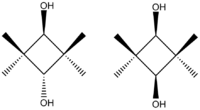2,2,4,4-Tetramethyl-1,3-cyclobutanediol
 trans- (left) and cis-2,2,4,4-Tetramethyl-1,3-cyclobutanediol (right) | |||
| |||
| Names | |||
|---|---|---|---|
| IUPAC name
2,2,4,4-tetramethyl-1,3-cyclobutanediol | |||
| Other names
1,1,3,3-tetramethyl-2,4-cyclobutanediol | |||
| Identifiers | |||
| 3D model (JSmol) |
|||
| ChemSpider | |||
| ECHA InfoCard | 100.019.219 | ||
| PubChem CID |
|||
| UNII | |||
| |||
| |||
| Properties | |||
| C8H16O2 | |||
| Molar mass | 144.21 g·mol−1 | ||
| Appearance | Crystalline white solid (powder) | ||
| Melting point | 126 to 134 °C (259 to 273 °F; 399 to 407 K) | ||
| Boiling point | 210 to 215 °C (410 to 419 °F; 483 to 488 K) | ||
| Hazards | |||
| Safety data sheet | |||
| Flash point | 51 °C (124 °F; 324 K) | ||
| Except where otherwise noted, data are given for materials in their standard state (at 25 °C [77 °F], 100 kPa). | |||
| | |||
| Infobox references | |||
2,2,4,4-Tetramethyl-1,3-cyclobutanediol (CBDO) is an aliphatic diol. This diol is produced as a mixture of cis- and trans-isomers, depending on the relative stereochemistry of the hydroxyl groups. It is used as a monomer for the synthesis of polymeric materials. CBDO is currently being researched as an alternative to bisphenol A (BPA). BPA is a precursor used in the production of a wide range of polymers including polycarbonates, polyesters, polysulfones, and polyester ketones.
Replacement for BPA
The controversies associated with BPA in large quantities are ultimately related to its endrocrine disrupting abilities.[1] Like BPA, CBDO is a diol with a structure suitable for making polyesters. CBDO’s C4 ring is sufficiently rigid to prevent the two OH groups from forming cyclic structures. Unlike BPA, there is no current evidence of carcinogenic or toxic effects from CBDO-based consumer products. There are, however, few studies on the toxicology of CBDO for both long term and short term effects.
CBDO has potential advantages relative to BPA as a building block for production of polyesters. CBDO is very stable thermally and mechanically. Polyesters prepared from CBDO are rigid materials, but the combination of CBDO with flexible diols results in materials with high impact resistance, low color, thermal stability, good photooxidative stability and transparency.[2] As an added bonus, CBDO-derived polymers have high ductility.[3] The thermal and mechanical properties of CBDO-derived polyesters are often superior to conventional polyesters.[2]
Preparation
The first documented synthesis of CBDO involved pyrolysis of isobutyric anhydride followed by hydrogenation of the resulting dione.[4] This synthesis resembles the method used to produce CBDO today. The first step involves conversion of the isobutyric acid or its anhydride into the ketene. This ketene then dimerizes to form a four-membered ring with two ketone groups.
The product ring is hydrogenated to give a diol. The last step commonly involves catalytic hydrogenation with ruthenium, nickel, or rhodium catalysts. Hydrogenation of the diketone ring results in both cis and trans isomers.[3][5] A simplified scheme for the production of CBDO is presented below.

Structure and properties
The C4 ring of the cis isomer of CBDO is non-planar. For simple non-planar cyclobutanes, dihedral angles range from 19 to 31°. CBDO’s cis isomer crystallizes as two conformers with an average dihedral angle of 17.5° in the solid state.[6] The trans isomer, however has a dihedral angle of 0°.[7]
Polyesterification
The current economic method for the production of polyesters is direct esterification of dicarboxylic acids with diols. This condensation polymerization adds monomeric units to a chain. Individual chains react with one another through carboxyl and hydroxyl terminal groups. Finally, transesterification occurs within the chain.[8] Although CBDO is most often used in polyesters, mixed copolycarbonates of CBDO and a series of bisphenols have also been synthesized. The differing reactivities of the cis and trans isomers have not been studied in depth.
References
- ↑ vom Saal Frederick S., Hughes Claude. An Extensive New Literature Concerning Low-Dose Effects of Bisphenol A Shows the Need for a New Risk Assessment. Environ. Health Perspective. Volume 113, 2005, pp. 926–33.doi:10.1289/ehp.7713
- 1 2 Hoppens, Nathan C., Hudnall, Todd W., Foster, Adam, Booth, Chad J. Aliphatic-aromatic copolyesters derived from 2,2,4,4-tetramethyl-1,3-cyclobutanediol. Journal of Polymer Science: Part A: Polymer Chemistry. Volume 42, 2004, pp. 3473-3478. doi:10.1002/pola.20197
- 1 2 Kelsey, Donald R., Scardion, Betty M., Grebowicz, Jamusz S., Chuah, Hoe H. High Impact, Amorphous Terephthalate Copolyesters of Rigid 2,2,4,4-Tetramethyl-1,3-cyclobutanediol with Flexible Diols. Macromolecules. Volume 33, 2000, pp. 5810-5818.doi:10.1021/ma000223+
- ↑ Wedekind, E., Weisswange, W. "Berichte Ueber die Synthese eines Diketons der Cyclobutanreihe" Berichte der deutschen chemischen Gesellschaft, 1906, Volume 39, pp.1631.doi:10.1002/cber.19060390287
- ↑ W. Theilheimer "1,3-Cyclobutanediols from 1,3-cyclobutandiones" Synthetic Methods of Organic Chemistry, 1962, Volume 16, pp. 29.
- ↑ Shirrell & Williams "The crystal and molecular structure of cis-2,2,4,4-tetramethyl-1,3-cyclobutanediol" Acta Crystallographica Section B. 1976, Volume 32, pp. 1867-1870.doi:10.1107/S0567740876006559
- ↑ Margulis, T.R. "Planar Cyclobutanes: Structure of 2,2,4,4-Tetramethylcyclobutane-trans-1,3-diol" J. Chem. Soc. D. 1969, pp. 215–216. doi:10.1039/C29690000215
- ↑ Horst Köpnick, Manfred Schmidt, Wilhelm Brügging, Jörn Rüter, Walter Kaminsky "Polyesters" in Ullmann's Encyclopedia of Industrial Chemistry, Wiley-VCH, Weinheim, 2002. doi:10.1002/14356007.a21_227
-CBDO-3D-balls.png)
-CBDO-3D-balls.png)